Geostatistics
�
WlLEY SERIES IN PROBABILITY AND STATISTICS
APPLIED PROBABILITY AND STATISTICS SECTION
Established by WALTER A. SHEWHART and SAMUEL S. WILKS
Editors: Vic Barnett, Noel A. C. Cressie, Nicholas I. Fisher,
Iain M. Johnstone, J. B. Kadane, David G. Kendall, David W. Scott,
Bernard W. Silverman. Adrian F. M. Smith, Jozef L. Teugels;
Ralph A. Bradiey, Emeritus, J. Stuart Hunter, Emeritus
A complete list of the titles in this series appears at the end of this volume.
�
Geostatistics
Modeling Spatial Uncertainty
JEAN-PAUL CHILES
Bureau de Recherches Gkologiques et Miniires
PTERRE DELFINER
TOTAL Exploration Production
A Wiley-Interscience Publication
JOHN WILEY & SONS, INC.
New York
Chichester Weinheim
Brisbane
Singapore - Toronto
�
This book is printed on acid-free paper. @
Copyright (9 1999 by John Wiley & Sons, Inc. All rights reserved.
Published simultaneously in Canada.
No part of this publication may be reproduced, stored in a retrieval
system or transmitted in any form or by any means, electronic,
mechanical, photocopying, recording, scanning or otherwise, except
as permitted under Sections 107 or 108 of the 1976 United States
Copyright Act, without either the prior written permission of the
Publisher, or authorization through payment of the appropriate per-copy
fee to the Copyright Clearance Center, 222 Rosewood Drive, Danvers,
MA 01923, (978) 750-8400, fax (978) 750-4744. Requests to the
Publisher for permission should be addressed to the Permissions
Department, John Wiley & Sons, Inc., 605 Third Avenue, New York,
NY 10158-0012, (212) 850-601 I , fax (212) 850-6008, E-Mail:
PERMREQ8 WILEY.COM.
Library of Congress Cataloging-in-Publication Data:
Chiles, Jean-Paul.
Geostatistics: modeling spatial uncertaintylJean-Paul Chiks,
Pierre Delfiner.
p.
cm. - (Wiley series in probability and statistics.
Applied probability and statistics section)
“A Wiley-Interscience publication.”
Includes bibliographical references and index.
ISBN 0-471-08315-1 (alk. paper)
I , Earth sciences-Statistical methods.
I. Delfiner, Pierre.
11. Title. 111. Series: Wiley series in probability and statistics.
Applied probability and statistics.
QE33.2.S82C45 1999
550’.72-&2 1
98-3599
Printed in the United States of America
1 0 9 8 7 6
�
Contents
Preface
Abbreviations
Introduction
Types of Problems Considered, 2
Description or Interpretation?, 7
1. Preliminaries
1.1. Random Functions, I 1
1.2.
1.3. Transitive Theory, 24
On the Objectivity of Probabilistic Statements, 22
2. Structural Analysis
2.1.
2.2.
2.3.
2.4.
2.5.
2.6.
2.7.
2.8.
2.9.
General Principles, 29
Variogram Cloud and Sample Variogram, 34
Mathematical Properties of the Variogram, 57
Regularization and Nugget Effect, 74
Variogram Models, 80
Fitting a Variogram Model, 104
Variography in Presence of a Drift, 115
Simple Applications of the Variogram, 128
Complements: Theory of Variogram Estimation and
Fluctuation, 137
3. Kriging
3.1. Introduction, 150
3.2. Notations and Assumptions, 152
ix
xi
1
11
29
150
V
�
vi
CONTENTS
3.3. Kriging with a Known Mean, 154
3.4. Kriging with an Unknown Mean, 164
3.5. Estimation of a Spatial Average, 193
3.6. Selection of a Kriging Neighborhood, 201
3.7. Measurement Errors and Outliers, 210
3.8. Case Study: The Channel Tunnel, 215
3.9. Kriging under Inequality Constraints, 224
4. Intrinsic Model of Order k
IRF-0 and IRF-k, 231
A Second Look at the Model of Universal Kriging, 233
Allowable Linear Combinations of Order k, 236
Intrinsic Random Functions of Order k, 243
Generalized Covariance Functions, 252
Estimation in the IRF Model, 265
Generalized Variogram, 276
Automatic Structure Identification in the General
Case, 281
4.1.
4.2.
4.3.
4.4.
4.5.
4.6.
4.7.
4.3.
5. Multivariate Methods
Introduction, 292
Notations and Assumptions, 293
Simple Cokriging, 296
Universal Cokriging, 298
Case of Gradient Information, 3 13
Multivariate Random Functions, 321
Shortcuts, 35 1
Space-Time Models, 362
5.1.
5.2.
5.3.
5.4.
5.5.
5.6.
5.7.
5.8.
231
292
6. Nonlinear Methods
375
6.1. Introduction, 375
6.2. Simple Methods for Estimating a Point Distribution, 376
6.3. Local Estimation of a Point Distribution by Disjunctive
Kriging, 388
6.4. Simple Methods for Estimating a Block Distribution, 419
6.5. Local Estimation of a Block Distribution by Disjunctive
Kriging, 437
�
CONTENTS
7. Conditional Simulations
7.1.
7.2.
7.3.
7.4.
7.5.
7.6.
7.7.
7.8.
7.9.
7.10.
7.11.
Introduction and Definitions, 449
Direct Conditional Simulation of a Continuous
Variable, 462
Conditioning by Kriging, 465
Turning Bands, 472
Nonconditional Simulation of a Continuous Variable, 478
Nonconditional Simulation of an IRF-4, 506
Sirnulation of a Categorical Variable, 520
Object-Based Simulations: Boolean Models, 545
Constrained Simulations, 56 1
Practical Considerations, 57 1
Case Studies, 577
8. Scale Effects and Inverse Problems
8.1. Introduction, 593
8.2. Upscaling Permeability, 594
8.3. Stochastic Differential Equations, 602
8.4. Inverse Problem in Hydrogeology, 61 1
Appendix
References
Index
vii
449
593
636
650
687
�
Preface
This book covers a relatively specialired subject matter, geostatistics, as it was
defined by Georges Matheron in 1962, when he coined this term to designate
his own methodology of ore reserve evaluation. Yet it addresses a larger au-
dience, for the applications of geostatistics now extend to many fields in the
earth sciences, including not only the subsurface but also the land, the atmo-
sphere, and the oceans.
The reader may wonder why such a narrow subject should occupy so many
pages. Our intent was to write a short book. But this would have required
us to sacrifice either the theory or the applications. We felt that neither of
these options was satisfactory-there
is no need for yet another introductory
book, and geostatistics is definitely an applied subject. We have attempted to
reconcile theory and practice by including application examples, which are
discussed with due care, and about 160 figures. This results in a somewhat
weighty volume, although hopefully more readable.
This book gathers in a single place a number of results that were either
scattered, not easily accessible, or unpublished. Our ambition is to provide
the reader with a unified view of geostatistics, with an emphasis on rnethodul-
ogy. To this end we detail simple proofs when their understanding is deemed
essential for geostatisticians, and omit complex proofs that are too technical.
Although some theoretical arguments may fall beyond the mathematical and
statistical background of practitioners, they have been included for the sake
of a complete and consistent development that the more theoretically inclined
reader will appreciate. These sections, as well as ancillary or advanced topics,
are set in smaller type.
Many references in this book point to the works of Matheron and the Center
for Geostatistics in Fontainebleau, which he founded at the Paris School of
Mines in 1967 and headed until his retirement in 1996. Without overlooking
the contribution of Gandin. Makrn, Yaglom, Krige, de Wijs, and many others,
it is from Matheron that geostatistics emerged as a discipline in its own right-
a body of concepts and methods, a theory and a practice-for
the study of
spatial phenomena. Of course this initial group spawned others, notably in
ix
�
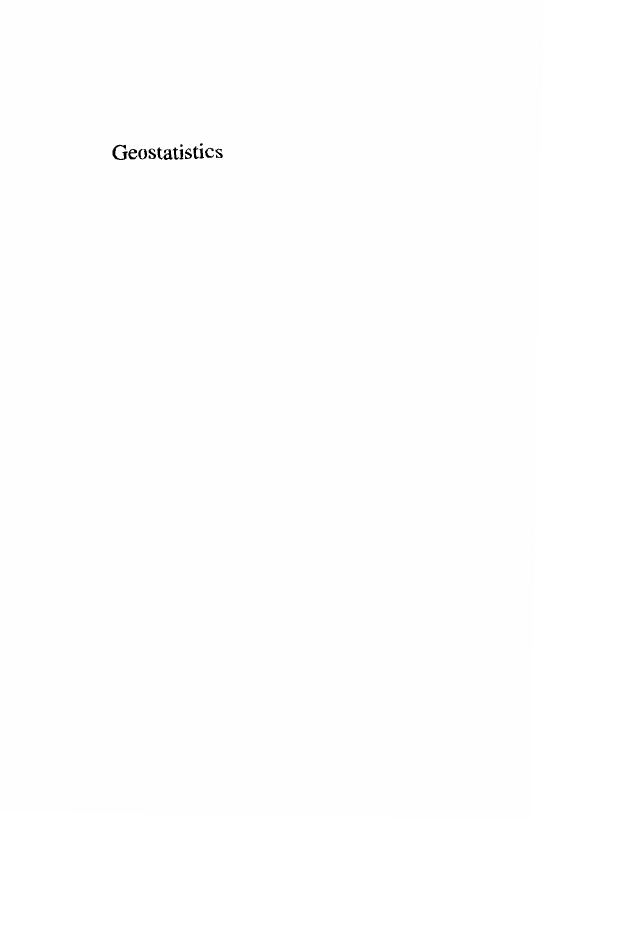
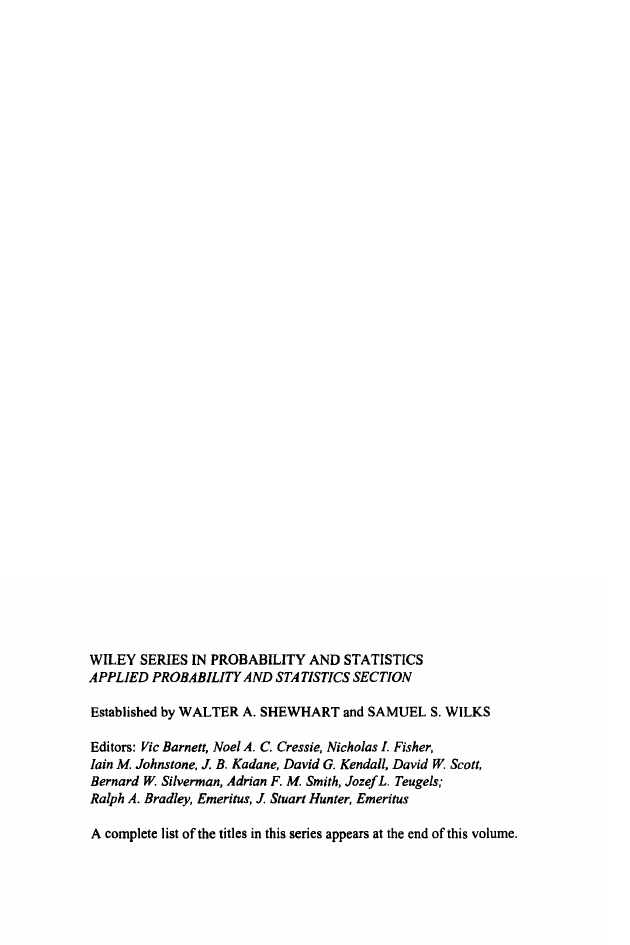
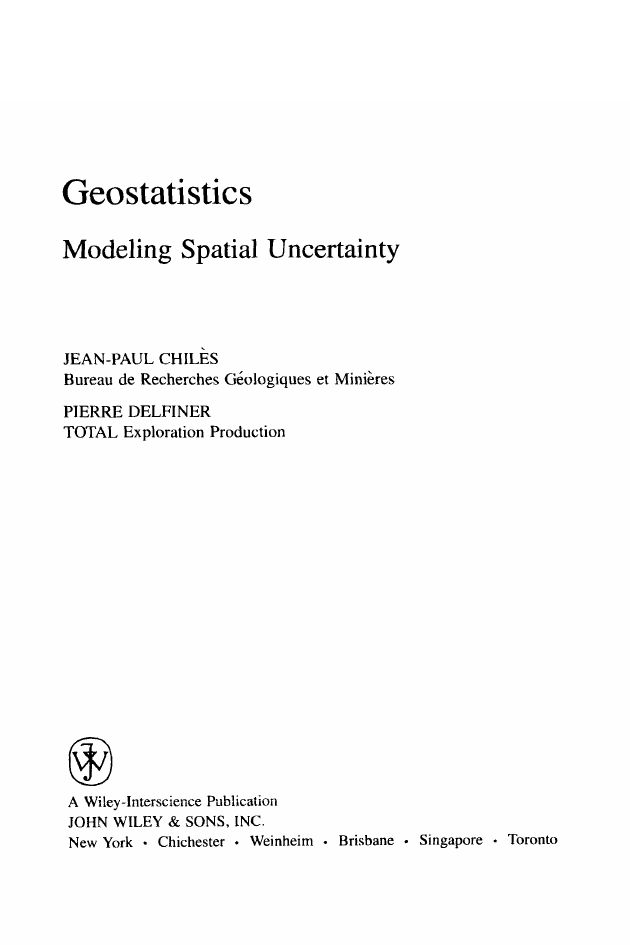
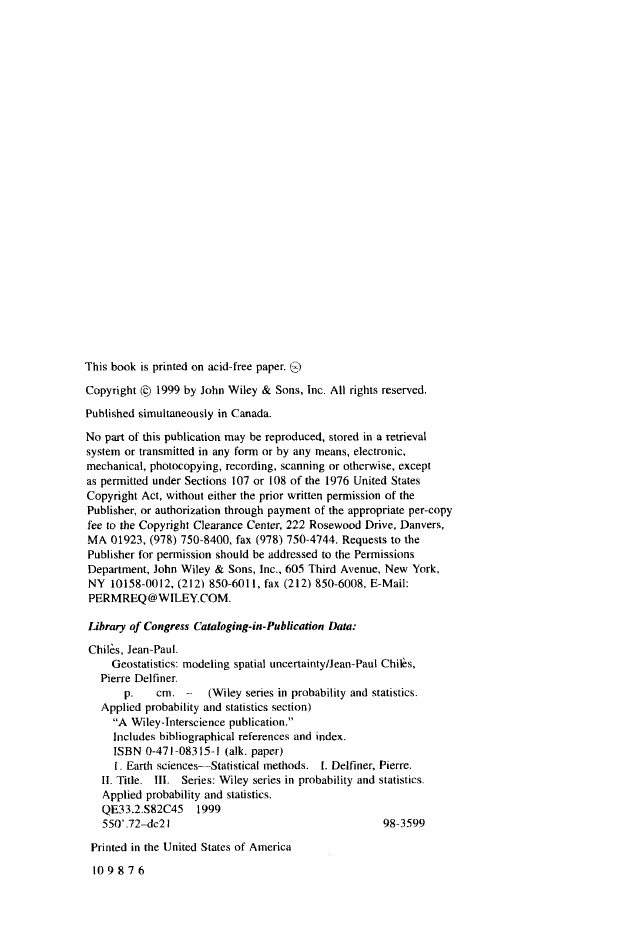
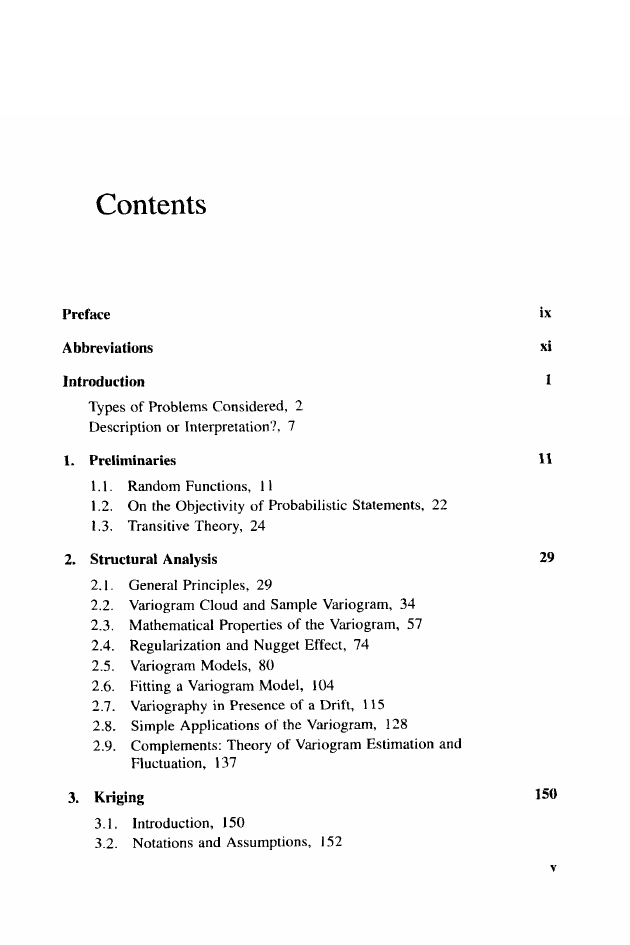

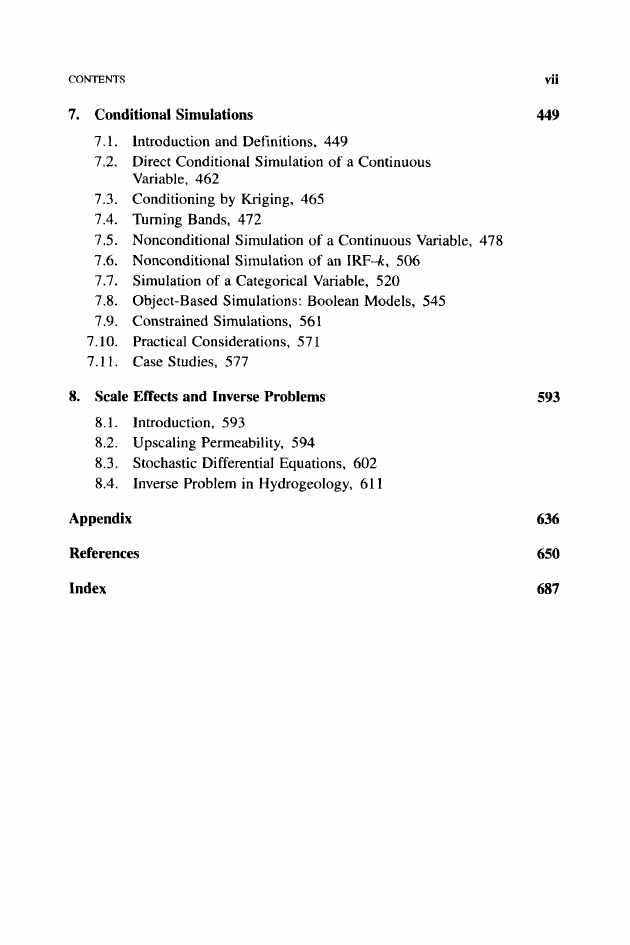
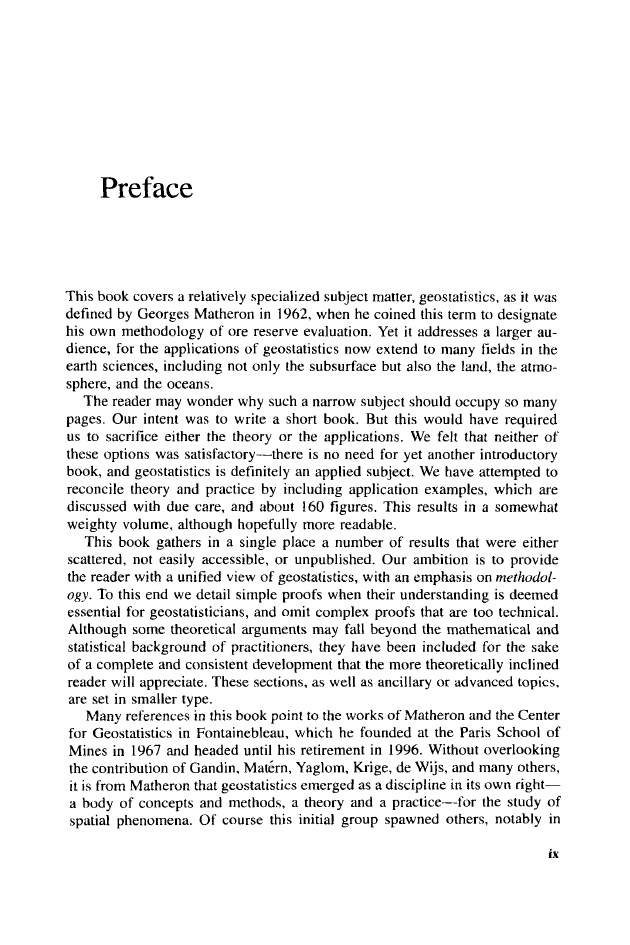








 2023年江西萍乡中考道德与法治真题及答案.doc
2023年江西萍乡中考道德与法治真题及答案.doc 2012年重庆南川中考生物真题及答案.doc
2012年重庆南川中考生物真题及答案.doc 2013年江西师范大学地理学综合及文艺理论基础考研真题.doc
2013年江西师范大学地理学综合及文艺理论基础考研真题.doc 2020年四川甘孜小升初语文真题及答案I卷.doc
2020年四川甘孜小升初语文真题及答案I卷.doc 2020年注册岩土工程师专业基础考试真题及答案.doc
2020年注册岩土工程师专业基础考试真题及答案.doc 2023-2024学年福建省厦门市九年级上学期数学月考试题及答案.doc
2023-2024学年福建省厦门市九年级上学期数学月考试题及答案.doc 2021-2022学年辽宁省沈阳市大东区九年级上学期语文期末试题及答案.doc
2021-2022学年辽宁省沈阳市大东区九年级上学期语文期末试题及答案.doc 2022-2023学年北京东城区初三第一学期物理期末试卷及答案.doc
2022-2023学年北京东城区初三第一学期物理期末试卷及答案.doc 2018上半年江西教师资格初中地理学科知识与教学能力真题及答案.doc
2018上半年江西教师资格初中地理学科知识与教学能力真题及答案.doc 2012年河北国家公务员申论考试真题及答案-省级.doc
2012年河北国家公务员申论考试真题及答案-省级.doc 2020-2021学年江苏省扬州市江都区邵樊片九年级上学期数学第一次质量检测试题及答案.doc
2020-2021学年江苏省扬州市江都区邵樊片九年级上学期数学第一次质量检测试题及答案.doc 2022下半年黑龙江教师资格证中学综合素质真题及答案.doc
2022下半年黑龙江教师资格证中学综合素质真题及答案.doc